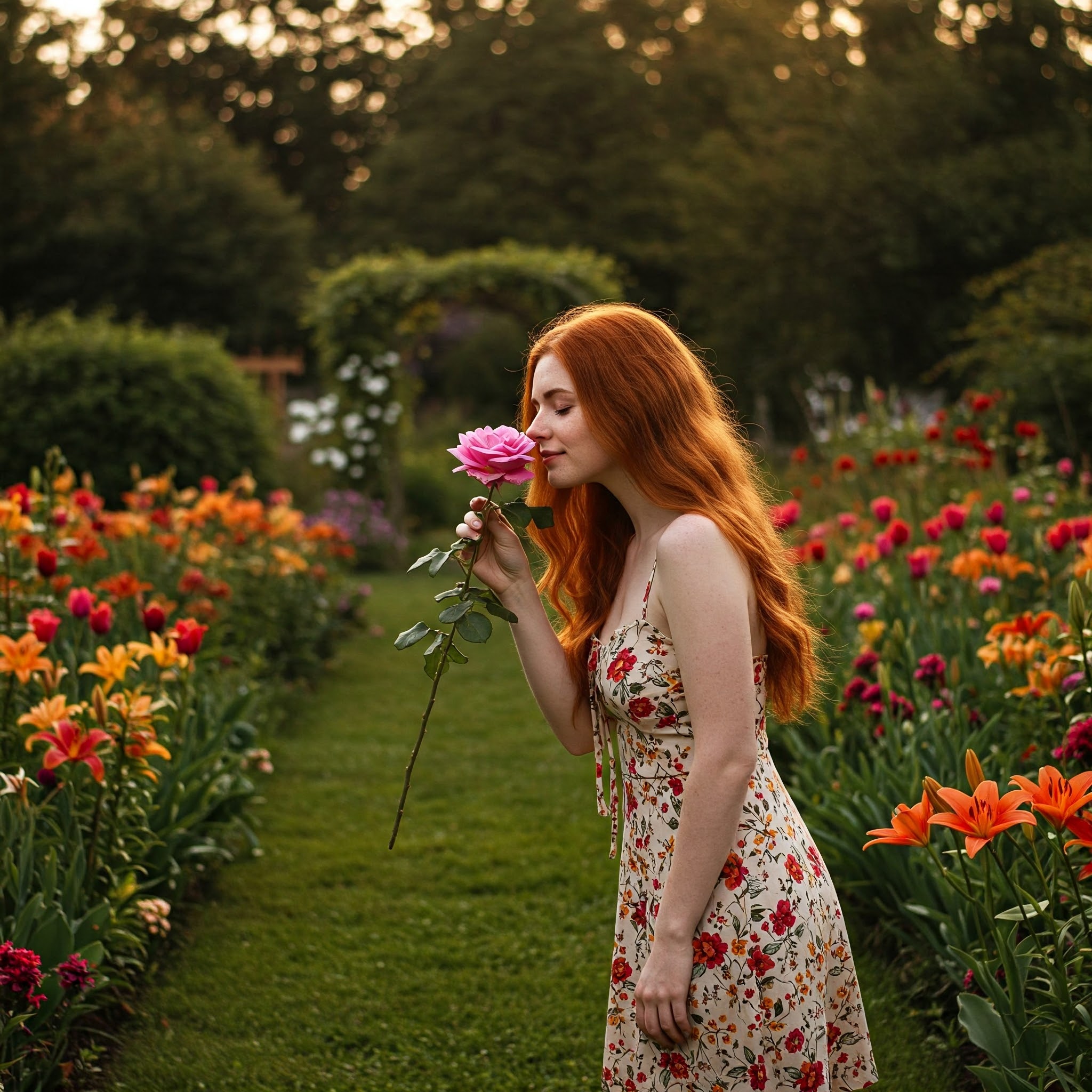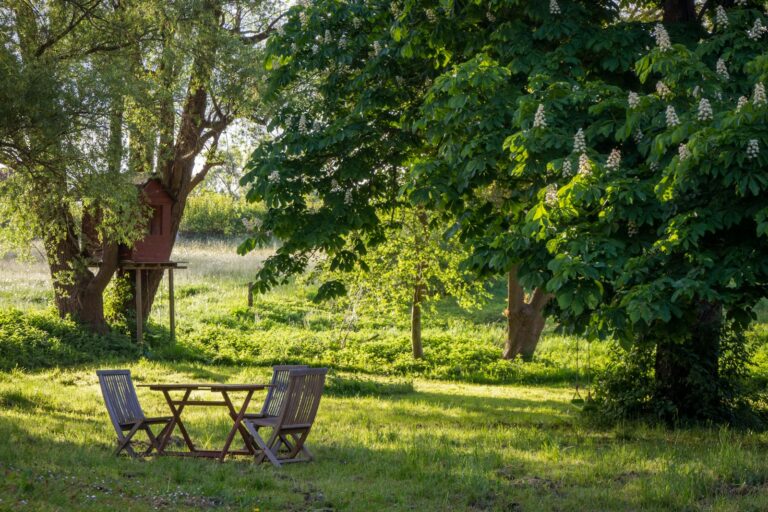Gardening Through the Five Senses: A Complete Sensory Experience
There’s something magical about stepping into a garden. The moment you cross that threshold, your entire being becomes awake to new experiences. The vibrant colors catch your eye, the fragrance of flowers drifts through the air, the rustle of leaves reaches your ears, and the textures of different plants invite your touch. And yes, sometimes, there’s even something delicious to taste.
This isn’t just gardening—it’s a full sensory journey that can transform an ordinary patch of earth into an extraordinary experience.
In our increasingly digital world, where screens dominate our attention, gardens offer a refreshing return to our sensory roots. They invite us to slow down, notice, and truly experience the world around us through all five senses. Whether you’re a seasoned gardener or someone who’s never picked up a trowel, understanding how to create and appreciate a garden through sight, smell, sound, touch, and taste can enrich both your outdoor space and your life.
This article explores how each of our five senses interacts with the garden environment and offers practical advice for enhancing these connections. By the end, you’ll have a roadmap for creating a space that doesn’t just look pretty, but engages your entire sensory system—a true garden of the senses.
Sight: The Visual Symphony of a Garden

When most people think of gardens, the visual aspect is often what comes to mind first. It’s the colors, shapes, and overall design that initially draw us in. But creating a visually stunning garden involves more than randomly planting pretty flowers.
Color Theory in the Garden
Colors in your garden can evoke different emotions and create various atmospheres. According to color psychology research published in the Journal of Environmental Psychology (2018), cool colors like blues and purples tend to create a sense of calm and serenity, while warm colors like reds, oranges, and yellows energize a space.
Consider these color effects when planning your garden:
- Red: Creates excitement and draws attention as a focal point
- Orange: Brings warmth and enthusiasm
- Yellow: Radiates cheerfulness and can brighten shady areas
- Green: Provides restfulness and stability (and comes naturally with most plants!)
- Blue: Creates a sense of depth and tranquility
- Purple: Adds sophistication and can make a space feel luxurious
Rather than creating a rainbow explosion, consider limiting your color palette in different sections of your garden. A monochromatic scheme using varying shades of the same color can create a cohesive, sophisticated look. Alternatively, complementary colors (those opposite each other on the color wheel) create vibrant contrast when placed together.
Playing with Form and Texture
Beyond color, the shapes and forms of plants contribute significantly to visual interest. Mix plants with different growth habits—tall spires of foxgloves or delphiniums rising above mounding plants like lavender or catmint, with groundcovers spreading below. This creates layers that lead the eye through the garden.
Landscape architect Julie Moir Messervy, in her book “The Inward Garden” (2007), suggests that thoughtfully designed gardens can actually guide how we move through a space. By creating “rooms” with different visual themes, you can craft a journey for visitors to experience.
I remember visiting the gardens at Sissinghurst Castle in England, where each garden section had its own color scheme and character. The famous “White Garden” used only white flowers and silver foliage to create a space that glowed in the evening light. It demonstrated how limitation can sometimes create the most magical effects.
Visual Interest Throughout the Year
A common mistake is creating a garden that looks spectacular for a few weeks but lackluster the rest of the year. A study by the Royal Horticultural Society (2020) found that gardens that maintain visual interest year-round significantly improve residents’ wellbeing.
To achieve this:
- Include plants with interesting winter structures like ornamental grasses or the peeling bark of paper birch trees
- Plant spring bulbs like daffodils and tulips for early color
- Choose summer-blooming perennials and annuals for the high season
- Add plants with spectacular fall color like maples, sumac, or asters
- Incorporate evergreens to maintain structure throughout the year
Consider sight lines from key viewing points—perhaps from your kitchen window or a favorite bench. What will you see in each season? Plan accordingly to ensure there’s always something captivating to look at.
Scent: The Invisible Dimension of Gardening
While a garden’s appearance might draw us in initially, it’s often the scents that create the deepest memories. The human brain processes smells differently than other sensory information—scent receptors connect directly to the limbic system, which handles memory and emotion. This explains why a particular garden fragrance can instantly transport you back to childhood or evoke powerful feelings.
Creating Scent Zones
Rather than randomly placing fragrant plants, consider creating “scent destinations” throughout your garden. The lavender walkway at the Huntington Botanical Gardens in California exemplifies this concept beautifully—as you stroll through, the brushing of legs against plants releases waves of fragrance.
Some suggestions for scent zones:
- Entryway: Plant fragrant climbers like jasmine or honeysuckle near your garden entrance for a welcoming aroma
- Seating areas: Surround benches with scented plants like roses or lilacs to enhance relaxation
- Evening spaces: Include night-scented plants like evening primrose or night-blooming jasmine near patios used after dark
Timing Your Scented Garden
Different plants release their fragrance at different times of day or seasons. Morning glories release their delicate scent at dawn, while evening primrose saves its perfume for twilight hours. By understanding these patterns, you can orchestrate a changing symphony of scents throughout the day and year.
Pamela Hardway, renowned aromatherapist and garden designer, notes in her book “The Scented Garden” (2019): “A well-designed scent garden should offer different olfactory experiences as the day progresses, much like a musical composition builds and changes through movements.”
Some examples to consider:
- Morning: Plant rosemary, mint, or lemon balm near breakfast areas—these release oils when touched by the morning sun
- Midday: Roses tend to be most fragrant when warm
- Evening: Nicotiana (flowering tobacco), moonflower, and angel’s trumpet release intoxicating scents as dusk falls
Fragrance and Wellbeing
The therapeutic effects of garden scents go beyond simple pleasure. According to research from Wheeling University (2022), exposure to certain plant fragrances can reduce stress hormones and lower blood pressure. Lavender’s calming properties are well-documented, while rosemary has been shown to improve memory and concentration.
When selecting fragrant plants, consider both their aesthetic qualities and their potential health benefits. Lemon balm might help reduce anxiety, while eucalyptus could help clear the respiratory system. Your garden can become not just beautiful but actively beneficial to your wellbeing.
Sound: The Garden’s Voice
The sonic dimension of gardens is often overlooked but can profoundly impact our experience. From the gentle rustle of ornamental grasses to the melodic trickle of water features, sound adds depth to the garden experience and can mask unwanted noise from roads or neighbors.
Plants That Speak to the Wind
Certain plants are natural sound-makers, their structures designed to respond to the slightest breeze:
- Quaking aspen trees: Their leaves tremble and rustle with the gentlest air movement
- Ornamental grasses: Varieties like Miscanthus and Pennisetum produce soothing whispers when grouped together
- Bamboo: Creates a distinctive hollow clatter as stems knock together
- Seed heads: Plants like love-in-a-mist or poppies produce subtle rattles when dry
The American Horticultural Society’s study on “Therapeutic Garden Design” (2021) found that these natural sounds significantly reduced stress levels among garden visitors, with effects comparable to guided meditation.
Inviting Songbirds and Beneficial Insects
Gardens can become natural amphitheaters for wildlife sounds if designed thoughtfully. The Cornell Lab of Ornithology’s research indicates that gardens with a mix of native plants, water sources, and structural diversity attract up to 8 times more bird species than conventional landscapes.
To create your own wildlife sound garden:
- Plant native species that produce berries or seeds for birds (serviceberry, coneflower, sunflower)
- Include a range of plant heights to create habitat niches
- Install a simple birdbath or shallow water feature
- Avoid chemical pesticides that harm insect populations
The buzz of bees, the chirp of crickets, and the songs of birds create a living soundscape that changes with the seasons. Each morning last summer, I would sit on my garden bench with my eyes closed, simply listening to the dawn chorus of birds and the gentle hum of bees visiting my lavender. It became a form of natural meditation.
Water Features: The Ultimate Sound Element
Perhaps nothing adds sound to a garden quite like moving water. According to landscape designer Andrew Wilson (2018), the sound of water masks unwanted noise more effectively than any other garden element while simultaneously creating a sense of tranquility.
Water features range from elaborate constructed waterfalls to simple ceramic bowls with small recirculating pumps. The key is matching the sound to your garden’s scale and style:
- Formal gardens: Consider structured fountains with gentle, consistent splashing
- Naturalistic gardens: Mimic streams with irregular stones creating varied water sounds
- Small spaces: Even a small wall-mounted water bowl can provide soothing burbles
Remember that water sounds change seasonally too—the gentle trickle of summer becomes more pronounced in fall rains, while winter might bring the delicate crystalline sounds of ice formations.
Touch: The Intimate Sense in the Garden

Unlike museums with their “do not touch” signs, gardens invite physical interaction. Touching plants connects us directly to nature in a way that simply looking cannot. From the silky petals of roses to the rough bark of oak trees, tactile experiences add another dimension to gardening.
Creating Touchable Moments
Intentionally designing areas that invite touch makes your garden more interactive and meaningful. Consider these approaches:
- Sensory paths: Create walkways with different textures underfoot—smooth flagstones, pebbly sections, and soft moss areas
- Reachable textures: Place interesting textural plants near edges where they can be easily touched
- Interactive features: Install a small water basin where visitors can dip their hands
Dr. Joanna Briggs, occupational therapist and garden designer, notes in her research on therapeutic gardens (2020): “Physical contact with natural materials provides sensory feedback that activates different parts of the brain than visual stimulation alone. This multi-sensory engagement is particularly valuable for cognitive development in children and cognitive maintenance in older adults.”
Plants Worth Touching
Some plants seem designed specifically for the sense of touch:
- Lamb’s ears (Stachys byzantina): Velvety silver leaves that feel like soft flannel
- Jerusalem sage (Phlomis fruticosa): Thick leaves with a soft, fuzzy texture
- Mexican feather grass (Nassella tenuissima): Silky, hair-like plumes that sway with the slightest touch
- Succulents: Firm, plump leaves with a cool, smooth surface
- Tree bark: From the papery exfoliation of river birch to the deep furrowed ridges of oak
I’ve noticed visitors to my garden invariably reach out to touch the silvery lambs’ ears planted along my pathway. Children especially are drawn to these tactile plants—a reminder that touch is our most primal sense and one of the first ways we explore the world.
Therapeutic Aspects of Garden Touch
Horticultural therapy programs worldwide utilize the sense of touch as a healing modality. Working with soil, handling seeds, and pruning plants provide tactile feedback that can be calming and grounding. According to the American Horticultural Therapy Association (2023), these physical interactions with plants have been shown to lower heart rates and reduce symptoms of anxiety.
Creating opportunities for productive touch—like herb gardens that require harvesting or roses that need deadheading—provides both sensory stimulation and purposeful activity. This combination proves particularly beneficial for individuals recovering from stress-related conditions or cognitive challenges.
Taste: The Garden’s Delicious Rewards
Perhaps the most primal connection between humans and plants comes through taste. Long before decorative gardens existed, humans cultivated plants primarily for food. Today, edible gardens reconnect us with that heritage while providing the freshest possible flavors.
Beyond the Vegetable Patch
While dedicated vegetable gardens are wonderful, edible plants can be incorporated throughout any garden style:
- Edible flowers: Nasturtiums, pansies, and borage add color to the garden and flavor to salads
- Fruit trees: Even small spaces can accommodate dwarf varieties that produce beautiful blossoms and delicious harvests
- Herb spirals: Compact, attractive structures that provide culinary herbs at varying heights
- Berry bushes: Blueberries and raspberries offer attractive foliage, flowers, and delicious fruits
The concept of “edible landscaping,” pioneered by Rosalind Creasy in the 1980s, demonstrates that food-producing plants can be just as attractive as ornamentals. Her research showed that a well-designed front yard edible landscape could produce over $700 worth of food annually in a typical suburban lot.
Seasonal Eating Through Garden Design
A thoughtfully designed edible garden can provide harvests throughout the growing season:
- Early spring: Asparagus spears, tender lettuces, and chives
- Summer: Tomatoes, cucumbers, beans, and berries
- Fall: Apples, pears, pumpkins, and root vegetables
- Winter: Kale, Brussels sprouts, and stored squashes
By planning for continuous harvests, you create an evolving relationship with your garden through taste. Each season brings new flavors and connections.
Chef and garden designer Sarah Raven notes in her book “Grow Cook Eat” (2017): “The connection between garden and kitchen transforms both spaces. When you grow food yourself, cooking becomes not just about following recipes but about responding to what the garden offers each day.”
Creating a Children’s Tasting Garden
Perhaps nowhere is the joy of edible gardening more evident than in spaces designed for children. Research from the University of California’s Cooperative Extension (2021) found that children who grow vegetables are five times more likely to eat them than those who don’t participate in gardening.
Consider creating a dedicated children’s tasting area with:
- Cherry tomatoes: Sweet, bite-sized, and abundant
- Strawberries: Accessible ground-level fruits with immediate reward
- Snap peas: Satisfying to pick and eat straight from the vine
- Sunflowers: Impressive growth for children to measure themselves against, with edible seeds as the finale
Last summer, my niece visited my garden and discovered alpine strawberries for the first time. The wonder on her face as she tasted these intensely flavorful tiny berries—so different from store-bought varieties—reminded me that taste experiences in the garden can create lifelong memories and connections to nature.
Bringing It All Together: The Complete Sensory Garden
The true magic happens when all five senses are engaged simultaneously in your garden space. This integration creates an immersive experience greater than the sum of its parts. Here’s how to bring everything together:
Designing Multi-Sensory Spaces
Consider creating specific areas designed to engage multiple senses:
- Morning coffee nook: East-facing seating surrounded by fragrant early bloomers, with textural groundcovers underfoot and a small water feature providing gentle sounds
- Evening relaxation space: West-facing placement to catch sunset colors, with night-scented plants, grasses that catch the light and rustle in evening breezes, and perhaps some mint or lemon balm nearby to pluck for evening tea
Landscape architect Clare Cooper Marcus, in her groundbreaking work on healing gardens (2019), found that spaces designed to engage multiple senses simultaneously showed the greatest therapeutic benefits for users.
Seasonal Sensory Mapping
One effective approach is to create a sensory map of your garden that tracks experiences through the seasons:
- Draw a simple plan of your garden
- For each season, note which plants or features engage each sense
- Look for gaps in the sensory experience and add elements accordingly
This mapping process often reveals that while spring and summer might offer abundant sensory experiences, fall and winter might need enhancement—perhaps with plants that have interesting seedheads, textured bark, or winter fragrance.
Accessibility Considerations
A truly inclusive sensory garden should be accessible to everyone, including those with sensory processing differences or physical limitations. Consider:
- Raised beds: Allow wheelchair users to touch and smell plants more easily
- Contrasting colors: Help those with visual impairments navigate the space
- Consistent path materials: Assist those with mobility challenges
- Quiet zones: Provide respite for individuals with sensory sensitivities
The Sensory Trust, a UK organization focused on inclusive design, reports that gardens designed with these principles benefit not just those with specific needs but enhance the experience for all visitors (2022).
Conclusion: The Garden as Teacher
A garden designed for all five senses does more than provide beauty or food—it becomes a teacher of mindfulness and presence. In our distracted world, few experiences engage us as completely as a well-designed sensory garden.
When we fully experience a garden through all our senses, we practice a form of natural mindfulness. We notice the changing light on leaves, detect subtle fragrances carried on the breeze, feel different textures beneath our fingers, hear the varied sounds of life around us, and taste the Earth’s bounty directly. This complete sensory engagement connects us to the rhythms of nature and, ultimately, to ourselves.
Whether you’re working with acres of land or a small balcony, the principles remain the same: create opportunities for sensory connection in your space. Start small if needed—perhaps with a container of fragrant herbs by your door or textural plants along a walkway—and expand as you observe how these elements affect your experience.
The garden experienced through all five senses doesn’t just feed the body; it nourishes the spirit. In cultivating such a space, we cultivate our own capacity for presence, wonder, and connection to the natural world—gifts that continue to grow with each sensory experience.




